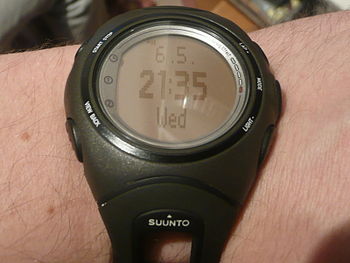One of the hardest things for new runners to do is learn how to pace themselves. It’s practically a rite of passage for someone heading out the door for their first jog – starting with a burst of energy and the best of intentions, but feeling winded before reaching the end of the block because they started out too fast. Keeping yourself at a reasonable pace is sometimes hard to do.
Thankfully, there are a number of different ways to coach yourself and to find the right pace. The simplest way to gauge your pace is by using a
stopwatch or wristwatch that has a stopwatch feature. Simply measure the routes that you run (as well as intermediate points along the way, such as every half mile or mile, if you want to be able to track your pace to an even greater detail), and use your stopwatch to make note of how quickly you run the known distance. If you run along roads or sidewalks you can measure those distances with your car or a bicycle with an odometer. You can even use an online service like
MapMyRun.com to calculate the distances. Some runners use a
GPS- enabled watch or an iPhone to measure their distances automatically during each run, and to get instant feedback on their pacing.
Music is another great way to help you run at a particular pace. If you want to listen to songs you already have on your iPod or other MP3 player, simply take note of the ones that keep you running at the pace you want, and make a playlist (or several playlists) of those songs. It might take a bit of experiment to find out which songs worst best for you.


If you’re willing to try something new, go to
PodRunner.com and download some of the free music mixes that are designed for running. The PodRunner mixes are organized by their “beats per minute” (or “BPM”), which makes it easy to match your cadence with a particular BPM in order to maintain a desired pace. If you want a bit of help, you can also use some of the mixes from
TreadmillTrainer, which also provide coaching and guidance along with the music.
Another way of pacing is not by speed or cadence, but by your level of effort. Unfortunately, it’s sometimes difficult to judge how hard we’re working simply by how we feel. Being in a bad mood, for example, might make an easy run seem much more difficult. A
heart rate monitor can be a great help in this regard. Most sports heart rate monitors consist of a small transmitter together with an adjustable elastic strap that you wear against your skin, across your lower chest. This monitor transmits your heart rate data to a compatible watch, so that you can always see just how hard you’re working. The heart rate monitor can also show when it’s time to start increasing your running speed in order to make sure that you’re still getting a hard enough workout.
These tips aren’t just useful for novice runners. Intermediate and advanced level runners can also take advantage of these techniques to keep themselves at the target pace for whatever type of workout is on their schedule.



No comments:
Post a Comment